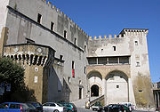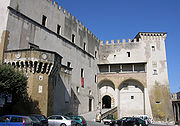
Pitigliano
Encyclopedia
Pitigliano is an Italian
town and comune
of province of Grosseto
in the Maremma
area of Tuscany
. The town stands on an abrupt tuff
butte high above the Olpeta, the Fiora and the Lente rivers.
times, but the first extant written mention of Pitigliano dates only to 1061. In the early 13th century it belonged to the Aldobrandeschi family, and by the middle of the century it had become the capital of the surrounding county.
In 1293 the county passed to the Orsini family, which signaled the start of a hundred and fifty years of on-again, off-again wars with Siena
, at the end of which, in 1455, a compromise of sorts was reached: Siena acknowledged the status of county to Pitigliano, which, in exchange, placed herself under the suzerainty of Siena.
 From thence onwards, the history of Pitigliano resorbs into the gradually wider ambit first of the Grand Duchy of Tuscany
From thence onwards, the history of Pitigliano resorbs into the gradually wider ambit first of the Grand Duchy of Tuscany
(1562), then of the united Kingdom of Italy.
. For this reason, the town was home to a flourishing and long-lived Jewish community, mostly made up by people fleeing from Rome during the Counterreformation persecutions. Jews of the town used one of the caves for their ritual Passover
matzoh bakery, the "forno delle azzime" described in detail in Edda Servi Machlin's "Classic Cuisine of the Italian Jews." http://www.amazon.com/dp/0896960897 After the promulgation of racial laws under Nazi influence, all the Jews of the town reportedly escaped capture with the help of their Christian neighbors.http://www.pitigliano-ferien.de/pr.jerusalem-e.html Although there are almost no Jews left in town, not enough to provide a minyan
, the synagogue (1598, with furnishings of the 17th and 18th centuries) is still officiated from time to time. It was restored in 1995.
") is a small cave, probably of natural origin but considerably reworked by human hands, lying a few hundred meters outside the central district, yet far above the Lente valley. Its purpose and builders remain unknown. Locally it is referred to as a "paleochristian tempietto", but this has never been confirmed; it must date to Late Antiquity
or the early Middle Ages, although it may replace an Etruscan or Roman arcosolium
http://penelope.uchicago.edu/Thayer/E/Gazetteer/Places/Europe/Italy/Toscana/Grosseto/Pitigliano/Pitigliano/Tempietto.html.
Italy
Italy , officially the Italian Republic languages]] under the European Charter for Regional or Minority Languages. In each of these, Italy's official name is as follows:;;;;;;;;), is a unitary parliamentary republic in South-Central Europe. To the north it borders France, Switzerland, Austria and...
town and comune
Comune
In Italy, the comune is the basic administrative division, and may be properly approximated in casual speech by the English word township or municipality.-Importance and function:...
of province of Grosseto
Province of Grosseto
The Province of Grosseto is a province in the Tuscany region of Italy. Its capital is the city of Grosseto.-Geography:It has an area of 4,504 km², and a total population of 227.498...
in the Maremma
Maremma
The Maremma is a vast area in Italy bordering the Tyrrhenian Sea, consisting of part of south-western Tuscany - Maremma Livornese and Maremma Grossetana , and part of northern Lazio - Maremma Laziale .The poet Dante Alighieri in his Divina Commedia places the...
area of Tuscany
Tuscany
Tuscany is a region in Italy. It has an area of about 23,000 square kilometres and a population of about 3.75 million inhabitants. The regional capital is Florence ....
. The town stands on an abrupt tuff
Tuff
Tuff is a type of rock consisting of consolidated volcanic ash ejected from vents during a volcanic eruption. Tuff is sometimes called tufa, particularly when used as construction material, although tufa also refers to a quite different rock. Rock that contains greater than 50% tuff is considered...
butte high above the Olpeta, the Fiora and the Lente rivers.
History
Pitigliano and its area were inhabited in EtruscanEtruscan civilization
Etruscan civilization is the modern English name given to a civilization of ancient Italy in the area corresponding roughly to Tuscany. The ancient Romans called its creators the Tusci or Etrusci...
times, but the first extant written mention of Pitigliano dates only to 1061. In the early 13th century it belonged to the Aldobrandeschi family, and by the middle of the century it had become the capital of the surrounding county.
In 1293 the county passed to the Orsini family, which signaled the start of a hundred and fifty years of on-again, off-again wars with Siena
Republic of Siena
The Republic of Siena , was a state originating from the city of Siena in Tuscany, Central Italy.It existed for over four hundreds years, from the late 11th century until the year 1555, when was defeated by the rival Duchy of Florence in alliance with the Spanish crown...
, at the end of which, in 1455, a compromise of sorts was reached: Siena acknowledged the status of county to Pitigliano, which, in exchange, placed herself under the suzerainty of Siena.

Grand Duchy of Tuscany
The Grand Duchy of Tuscany was a central Italian monarchy that existed, with interruptions, from 1569 to 1859, replacing the Duchy of Florence. The grand duchy's capital was Florence...
(1562), then of the united Kingdom of Italy.
Etruscan remains
Pitigliano is home to a series of artificial cuts into the tufa rock to varying depths ranging from less than one meter to over 10 meters. At the bottom of these cuts (Italian: tagliate) are carved channels, apparently for water, although some take the form of steps. The purpose of the cuts is not known: the three main theories are that they were roads, quarries, or water conveyance schemes; they radiate outward from the base of the butte of Pitigliano, down to the rivers then back to the top of the plateau that surrounds the town. A few very brief Etruscan inscriptions are said to have been found on the walls of the cuts, but are ill documented.Medieval and Renaissance monuments
- The former Cathedral of SS. Pietro e Paolo.
- The church of Santa Maria.
- The Orsini Fortress, which achieved its present state in 1545 but represents a reworking of the earlier medieval fortress
- the town's walls and gates, the best preserved of which is the Porta Sovana.
- remains of a tall and very visible aqueduct at the very top of the butte.
Synagogue and Jewish Community
For several hundred years Pitigliano was a frontier town between the Grand Duchy of Tuscany and, to the south, the Papal StatesPapal States
The Papal State, State of the Church, or Pontifical States were among the major historical states of Italy from roughly the 6th century until the Italian peninsula was unified in 1861 by the Kingdom of Piedmont-Sardinia .The Papal States comprised territories under...
. For this reason, the town was home to a flourishing and long-lived Jewish community, mostly made up by people fleeing from Rome during the Counterreformation persecutions. Jews of the town used one of the caves for their ritual Passover
Passover
Passover is a Jewish holiday and festival. It commemorates the story of the Exodus, in which the ancient Israelites were freed from slavery in Egypt...
matzoh bakery, the "forno delle azzime" described in detail in Edda Servi Machlin's "Classic Cuisine of the Italian Jews." http://www.amazon.com/dp/0896960897 After the promulgation of racial laws under Nazi influence, all the Jews of the town reportedly escaped capture with the help of their Christian neighbors.http://www.pitigliano-ferien.de/pr.jerusalem-e.html Although there are almost no Jews left in town, not enough to provide a minyan
Minyan
A minyan in Judaism refers to the quorum of ten Jewish adults required for certain religious obligations. According to many non-Orthodox streams of Judaism adult females count in the minyan....
, the synagogue (1598, with furnishings of the 17th and 18th centuries) is still officiated from time to time. It was restored in 1995.
The "Tempietto"
The Tempietto ("Small templeTemple
A temple is a structure reserved for religious or spiritual activities, such as prayer and sacrifice, or analogous rites. A templum constituted a sacred precinct as defined by a priest, or augur. It has the same root as the word "template," a plan in preparation of the building that was marked out...
") is a small cave, probably of natural origin but considerably reworked by human hands, lying a few hundred meters outside the central district, yet far above the Lente valley. Its purpose and builders remain unknown. Locally it is referred to as a "paleochristian tempietto", but this has never been confirmed; it must date to Late Antiquity
Late Antiquity
Late Antiquity is a periodization used by historians to describe the time of transition from Classical Antiquity to the Middle Ages, in both mainland Europe and the Mediterranean world. Precise boundaries for the period are a matter of debate, but noted historian of the period Peter Brown proposed...
or the early Middle Ages, although it may replace an Etruscan or Roman arcosolium
Arcosolium
An arcosolium is an arched recess used as a place of entombment. The word is from Latin arcus, "arch", and solium, "sill" ....
http://penelope.uchicago.edu/Thayer/E/Gazetteer/Places/Europe/Italy/Toscana/Grosseto/Pitigliano/Pitigliano/Tempietto.html.
External links
- Official site of the comune of Pitigliano
- Peter Petri's site
- Thayer's Gazetteer of Italy
- Tuscan Villas
- The Tuff Jewel in the Tuscan Maremma

